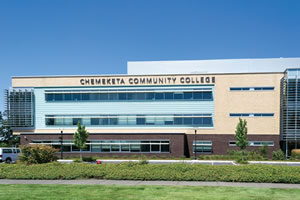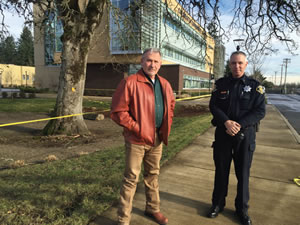Securing Open College Campuses
- By Michael Fickes
- 04/01/16

PHOTO COURTESY OF VISITOR7
A couple years ago, a crime spree broke out on a large university campus during football
season. It began on a Saturday during a football game,
which tied up most of the university’s security resources. Thieves
broke into a number of offices in one of the academic buildings,
stealing laptops and other valuables.
Throughout the next three weeks, the thieves broke into many
more buildings using an effective modus operandi. They dressed
like students and entered their target building while it was open.
Later, before the building closed for the day, they hid. Emerging
after the doors were locked, they used carpentry tools to break into
offices and make off with their loot.
After dozens of burglaries, they finally made a mistake. An
administrative assistant discovered a bus pass on the floor of her
office when she came to work on a Monday. When she noticed that
her office had been robbed, she called security.
Using the bus pass, the campus police, who happened to be
sworn officers, narrowed down the buses that might have carried
the thieves to campus. They focused on one bus and matched the
pass to a man appearing on camera video in front of the buildings
that had been burglarized.
The detectives set up a surveillance detail in a building that
hadn’t been burglarized — the thieves never hit the same building
twice. Finally, on yet another game-day Saturday, a plainclothes officer
watching a building heard what sounded like the rattle of burglar
tools at an office door. He called the campus police, who nabbed the
two burglars as they exited a set of the building’s fire doors.
They were charged and convicted of 40 burglaries and other thefts.
Today’s Open Campus
The spate of burglaries on that campus highlights what can and
does happen on an open college or university campus. An open campus
invites general public visitors as well as the campus community
to come and go as they please from the property. Free to wander the
campus, criminals can evaluate, make plans and commit crimes.
As a result of thefts and other campus criminal activities that
have gone tragically beyond theft, college and university security
directors are working on ideas to help make open campuses safer.
“Certainly parents have concerns for kids that attend residential
colleges — not just for the quality of the education provided but also
for the safety of the students,” says Tony Callisto, senior vice president
and chief law enforcement officer in the Division of Campus
Safety and Emergency Services at New York’s Syracuse University.
“As you think about what has occurred on college campuses
over the past decade or so, the interest in campus security has
been heightened,” continues Callisto. “The nature of the incidents
has grown very serious — there was the mass shooting at Virginia
Tech followed by other violent incidents. There is also the terrible
problem of sexual assault on campus.
“All of this makes it important that campus security departments
provide resources and services and educate university
communities about using those services.”

PHOTO COURTESY OF CHEMEKETA COMMUNITY COLLEGE
LIVE AND LEARN… AND LIVE. In his work as public safety director at Chemeketa
Community College in Oregon, Bill Kohlmeyer, left, with a campus officer, is continually
reviewing information on safety, access control and other aspects of security and then
making improvements to Chemeketa’s campus. By studying the experiences of and reports
from other institutions and experts, Kohlmeyer is confident that he is doing all he can to
keep Chemeketa’s students, faculty, staff and visitors safe.
Planning Security
Open campuses attract pedestrian traffic and vehicle traffic
from off campus, making it difficult to set up and control anything
close to a secure perimeter.
“Access control is difficult on an open campus,” says Paul
Timm, physical security consultant for RETA Security, Inc. “We
want a good perimeter, but it isn’t easy. People can walk in and
cars can drive in at any time. From a security point of view, it
would be good to account for vehicles and people, and everyone is
trying to do a better job of that.”
Timm goes on to describe the general security measures taken
on most campuses. More and more, residence halls are locked
all the time. Residents must card in with authorized, validated
credentials. The same holds true with dining facilities.
The academic buildings remain unlocked, continues Timm.
“In K–12 schools, teachers and students practice lockdowns,”
Timm notes. “But in higher educational facilities, they generally
don’t even have fire drills, let alone active shooter drills. There is
some drilling, but colleges and universities are generally behind
K–12 in preparing for these kinds of emergencies.”
Timm and other campus security professionals also focus on educating
the campus community. Timm offers courses in several areas:
- Designing access control systems.
- Natural surveillance — campus architecture that provides
clear, unobstructed sightlines. Criminals don’t like environments
where they can be seen easily.
- Maintenance — experience shows that well maintained, well-kept
campuses suffer less crime.
- Border definition — Defined perimeters help discourage crime
by making it clear when you cross onto a particular property. On
a campus, a stone wall, iron fence or low-slung shrubbery can
define a perimeter.
Get the Word Out
Bill Kohlmeyer, public safety director at Chemeketa Community
College in Salem, OR, also focuses on educating his campus
community about security.
“The courses are designed for unarmed, untrained civilians,”
he says. “One course, for instance, talks about how might you
survive an active shooter. I hold classes as often as once a week for
anyone that wants to come. We recently began getting requests
from people and businesses in the community.”
Kohlmeyer recently changed out all of the door locks on campus.
The old locks required a key to lock and unlock the doors —
from the outside. “There was no way to lock the doors from the
inside,” Kohlmeyer says. “These are the kind of locks that many
schools still have.”
The new locks can be locked quickly from the inside.
“We’ve also modified double doors leading to the outside,” continues
Kohlmeyer. “Seung-Hui Cho chained the two-fold handles on double doors to keep the police out of the building while keeping
the victims in.
“We studied the way people use these kinds of doors and found
that people almost always go out of a building through the righthand
side. So we’ve taken the left-side fold-handle off. It doesn’t
affect exiting, but no one can chain the doors shut.”
Kohlmeyer also studied how people under life-or-death stress
react and imagined what he might do to help them survive. For
instance, he found the people under severe stress often couldn’t
remember their address when calling 911.
The Chemeketa campus spans 200 acres and 63 buildings.
Together those buildings enclose hundreds of individual rooms.
“I started thinking about people hiding inside those rooms
during an attack,” Kohlmeyer says. “I wanted to make it easy
for them to call for help. So we installed signs inside every room
above the door. The signs have the building number and room
number. When students call for help from any room, all they have
to do is read the sign.”
Kohlmeyer also printed the building number and room number
of each room on outfacing windows to make it easier for first
responders to find their way around the buildings.
Emergency Notification
Kohlmeyer has installed two mass notification systems at Chemeketa:
an IP-based phone system with speakers on all of the phones
along with large speakers in common areas. “We can broadcast to a
room, a building, a group of buildings and the whole campus,” he says.
The second emergency notification system sends messages by
text, phone message, email and all of the above.
Is there an advantage to having two mass notification systems? “Yes,”
says Kohlmeyer. “Both systems warn people on campus. The emergency
messaging system can also warn people that are off campus to stay away.
“We also use the text messaging system to notify people of
weather delays and other emergencies — but we only use it for
emergencies.”
Finally, Kohlmeyer’s department employs uniformed, unarmed
security officers that monitor the campus 24 hours a day.
All in all, college campuses appear to be growing safer and more
secure. Thanks to the creativity and innovativeness of today’s college
and university security professionals, the additional security is
becoming available without sacrificing the easy, comfortable and fun
campus experience that everyone who remembers his or her college
days treasures and wants for today’s students.
This article originally appeared in the issue of .